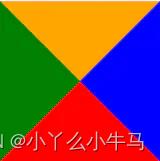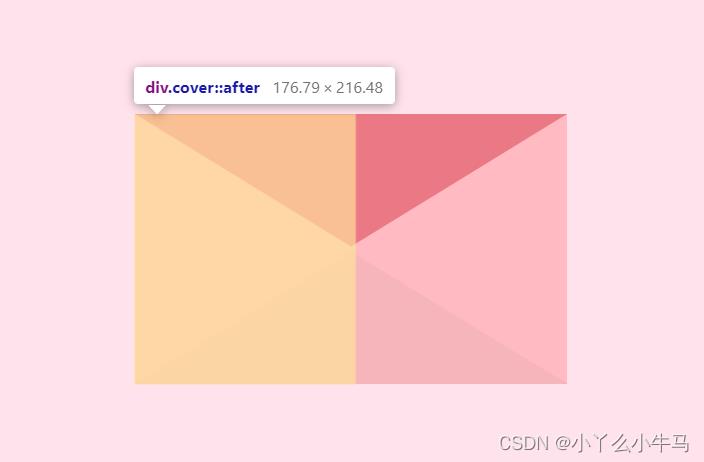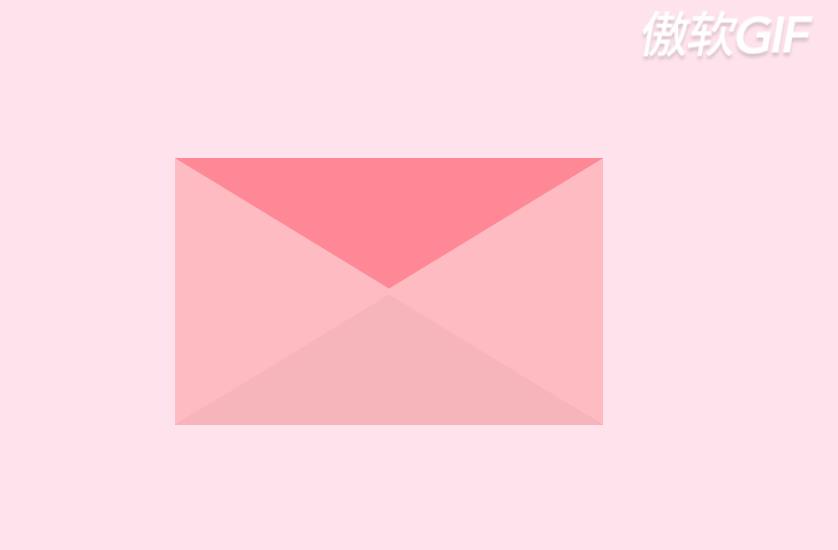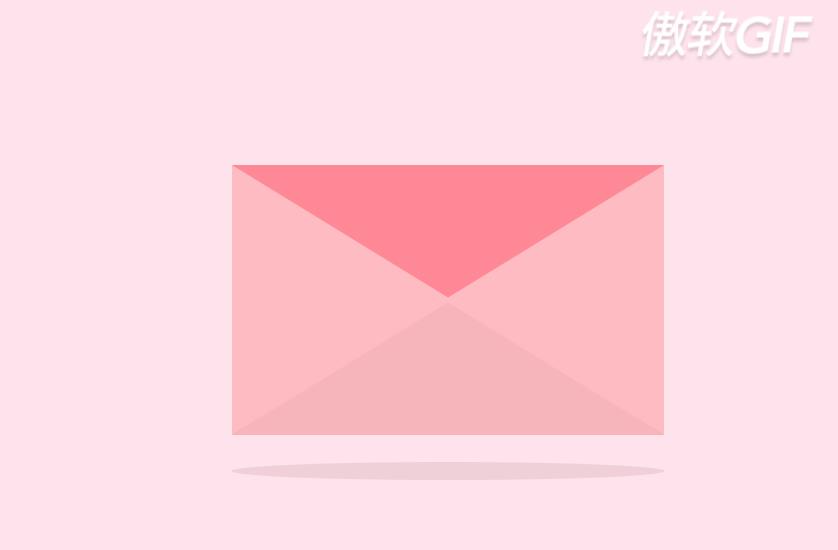叮咚,您有一封520信件待查收(原生HTML+CSS+JS绘制表白信件,代码+链接+步骤详解)
Posted 小丫么小牛马
tags:
篇首语:本文由小常识网(cha138.com)小编为大家整理,主要介绍了叮咚,您有一封520信件待查收(原生HTML+CSS+JS绘制表白信件,代码+链接+步骤详解)相关的知识,希望对你有一定的参考价值。
马上就要5月20号啦,准备好如何向心仪的她/他表白了嘛!特此出一篇告白小信件,效果图如下。纯html+css绘制,包含详细教程注释,干货满满哦。
链接置于文章结尾总结处。

文章目录
一、叮咚!查收您的信件!
信件页面主要由信封,卡片,以及卡片上的皮卡丘组成。接下来也将分三部分进行讲解。
我们先创建envelope.html及envelope.css。
1.envelope
1.1 绘制信封主体
envelope.html
首先,绘制我们的信封,创建类名为container的<div>及类名为envelope的<div>。
我们将信封,卡片,以及卡片上的皮卡丘放在一个container中,方便我们调适三者统一的位置。
代码如下:
<!DOCTYPE html>
<html lang="en">
<head>
<meta charset="UTF-8">
<title>envelope</title>
<link rel="stylesheet" href="envelope.css">
</head>
<body>
<div class="container">
<div class="envelope"></div>
</div>
</body>
</html>
envelope.css
在最开始导入我们后面将会用到的字体样式。
接着,重置浏览器样式,设置背景颜色,及信封颜色和大小。
其中,container和envelope均设置为相对定位。
绝对定位和相对定位,总结一下就是不希望影响到其他元素的就设置为绝对定位,反之,需要在页面中占有位置的就设置为相对定位。具体实例见此文对Absolute(绝对定位)与Relative(相对定位)的解析。
- vw:视窗宽度的百分比(1vw 代表视窗的宽度为 1%)
- vh:视窗高度的百分比
- vmin:当前 vw 和 vh 中较小的一个值
- vmax:当前 vw 和 vh 中较大的一个值
代码如下:
@import url('https://fonts.googleapis.com/css2?family=Pangolin&display=swap');
/*重置浏览器样式*/
*
margin: 0;
padding: 0;
/*
使主体居中
vw:视窗宽度的百分比(1vw 代表视窗的宽度为 1%)
vh:视窗高度的百分比
*/
body
height: 100vh;
width: 100vw;
background: #FFE3EC;
font-family: 'Pangolin', cursive;
font-size: 1vmin;
/*弹性布局*/
display: flex;
/*设置flex子项在每个flex行的交叉轴上的中心对齐,交叉轴方向为column,即垂直方向**/
align-items: center;
/*设置flex子项在主轴上的中心对齐*/
justify-content: center;
/*
使用相对定位(什么时候用相对定位或绝对定位?在文档流中相对定位的元素占有位置,而且会影响后面的元素(块元素、行内块元素),比如两个div并排,另外一个会换行。而绝对定位就是把该元素从文档流中踢出,不会占用文档流的位置,也不会影响后面的元素。)
vmin:当前 vw 和 vh 中较小的一个值
vmax:当前 vw 和 vh 中较大的一个值
*/
.container
position: relative;
top: 0vmin;
/*相对定位,并设置背景色和大小*/
.envelope
position: relative;
background: #eb7885;
height: 30vmin;
width: 48vmin;
运行效果:

1.2 绘制信封细节
信封主要由上下左右四个颜色不同的三角形组成。
我们加入一个新的<div>命名为cover,在原先的信封上覆盖上该元素。
<div class="cover"></div>
并通过设置该元素前后伪元素的样式形成四个三角。
加入该<div>后的html代码如下:
envelop.html
<!DOCTYPE html>
<html lang="en">
<head>
<meta charset="UTF-8">
<title>envelope</title>
<link rel="stylesheet" href="envelope.css">
</head>
<body>
<div class="container">
<div class="envelope"></div>
<div class="cover"></div>
</div>
</body>
</html>
envelop.css
可以看到,信封有四个三角形组成。
1.2.1 CSS绘制三角形—border法
那么如何绘制出三角形呢?
(会的看官可以直接往下)
这里我们使用 CSS 盒模型中的 border(边框) 即可实现。
原理:
首先来看在为元素添加 border 时,border 的样子。假设有如下代码(与本文所写项目无关):
<div></div>
div
width: 50px;
height: 50px;
border: 2px solid orange;
效果图:

这是我们平常使用 border 最普遍的情况——往往只给 border 一个较小的宽度(通常为 1 ~ 2px);然而这样的日常用法就会容易让大家对 border 的形成方式产生误解,即认为元素的 border 是由四个矩形边框拼接而成。
然而事实并不是这样。实际上,元素的 border 是由三角形组合而成,为了说明这个问题,我们可以增大 border 的宽度,并为各 border 边设置不同的颜色:
div
width: 50px;
height: 50px;
border: 40px solid;
border-color: orange blue red green;
效果图

既然如此,那么更进一步,把元素的内容尺寸设置为 0 会发生什么情况呢?
div
width: 0;
height: 0;
border: 40px solid;
border-color: orange blue red green;
效果图

我们将发现,此时元素由上下左右 4 个三角形“拼接”而成;那么,为了实现最终的效果,即保留最下方的三角形,还应该怎么做?很简单,我们只需要把其它 border 边的颜色设置为白色或透明色:
div
width: 0;
height: 0;
border: 40px solid;
// 分别代表:上 左右 下
border-color: transparent transparent red;
效果图

不过,被“隐藏”的上border 仍然占据着空间,要想使得绘制出的三角形尺寸最小化,还需要将上 border的宽度设置为 0(其它情况同理)。
1.2.2 绘制信封
绘制我们的信件
相信看了上面的讲解,大家一定了解了如何绘制三角形了。接下来我们将cover即其前后伪元素绘制成如下三个三角形。完成我们信封的制作。
(不了解伪元素的可以看下这篇::before选择器和::after选择器)



由于cover元素不应该影响envelope元素在页面中的位置,所以设置为绝对定位。但我们又需要该元素显示在envelope之上,我们通过修改元素的堆叠顺序,来实现该效果,即设置 z-index: 3;代码如下:
envelope.css
.cover
position: absolute;
height: 0;
width: 0;
border-bottom: 15vmin solid #f5b5bb;
border-left: 24vmin solid transparent;
border-right: 24vmin solid transparent;
top: 15vmin;
z-index: 3;
.cover::after /*left triangle*/
position: absolute;
content: '';
border-left: 24.5vmin solid #ffbbc1;
border-bottom: 15vmin solid transparent;
border-top: 15vmin solid transparent;
top: -15vmin;
left: -24vmin;
.cover::before
position: absolute;
content: '';
border-right: 24.5vmin solid #ffbbc1;
border-bottom: 15vmin solid transparent;
border-top: 15vmin solid transparent;
top: -15vmin;
left: -0.5vmin;
最终效果如下:

1.3 信封开合动画
接着绘制信封开合的动画。信封的开合同样是一个三角形,绕信封顶部边缘旋转180°实现的。
我们先加入该三角形的<div>命名为lib加入到envelope.html中。
<div class="lid"></div>
envelope.html
<!DOCTYPE html>
<html lang="en">
<head>
<meta charset="UTF-8">
<title>envelope</title>
<link rel="stylesheet" href="envelope.css">
</head>
<body>
<div class="container">
<div class="envelope"></div>
<div class="cover"></div>
<div class="lid"></div>
</div>
</body>
</html>
接着创建信件开合的动画,分别为open和open-rev。
我们使用transform属性,该属性允许我们对元素进行旋转、缩放、移动或倾斜。
设置参数rotate(angle) 定义 2D 旋转,在参数中规定角度。在这里我们将angle分别设置为180deg和-180deg,从而实现三角形的旋转,呈现效果为信封的开合。
动画定义代码如下:
envelope.css
@keyframes open
100%
transform: rotatex(180deg);
/*信件合上的动画*/
@keyframes open-rev
from
transform: rotatex(-180deg);
接着,我们将该元素绘制为三角形,并通过transform-origin属性,设置旋转元素的基点位置。
通过animation属性为该元素设置定义好的动画,及动画执行时间。当鼠标hover于信封时,信封打开,反之信封合上。
代码如下:
envelope.css
.lid
position: absolute;
height: 0;
width: 0;
border-top: 15vmin solid #ff8896;
border-left: 24vmin solid transparent;
border-right: 24vmin solid transparent;
top: 0;
/*设置旋转元素的基点位置,为盒子的顶部边缘*/
transform-origin: top;
animation: open-rev 2s;
.container:hover .lid
animation: open 0.5s;
animation-fill-mode: forwards;
至此,我们的信封就大功告成啦!
运行效果:

1.4 加入阴影
这一步较为,简单,也可以省略该元素,加入显得稍有立体感。
首先,在envelope.html中加入类名为shadow的元素。
envelope.html
<!DOCTYPE html>
<html lang="en">
<head>
<meta charset="UTF-8">
<title>envelope</title>
<link rel="stylesheet" href="envelope.css">
</head>
<body>
<div class="container">
<div class="envelope"></div>
<div class="cover"></div>
<div class="lid"></div>
<div class="shadow"></div>
</div>
</body>
</html>
随后设置该元素的样式,为一个较窄的横向的椭圆。
envelope.css
.shadow
position: relative;
top: 3vmin;
border-radius: 50%;
opacity: 0.7;
height: 2vmin;
width: 48vmin;
background: #e8c5d0;
我们envelop部分至此就完成了!
运行效果如下:

1.5 envelope全部代码
envelope.html
<!DOCTYPE html>
<html lang="en">
<head>
<meta charset="UTF-8">
<title>envelope</title>
<link rel="stylesheet" href="envelope.css">
</head>
<body>
<div class="container">
<div class="envelope"></div>
<div class="cover"></div>
<div class="lid"></div>
<div class="shadow"></div>
</div>
</body>
</html>
envelope.css
@import url('https://fonts.googleapis.com/css2?family=Pangolin&display=swap');
/*重置浏览器样式*/
*
margin: 0;
padding: 0;
/*
使主体居中
vw:视窗宽度的百分比(1vw 代表视窗的宽度为 1%)
vh:视窗高度的百分比
*/
body
height: 100vh;
width: 100vw;
background: #FFE3EC;
font-family: 'Pangolin', cursive;
font-size: 1vmin;
/*弹性布局*/
display: flex;
/*设置flex子项在每个flex行的交叉轴上的中心对齐,交叉轴方向为column,即垂直方向**/
align-items: center;
/*设置flex子项在主轴上的中心对齐*/
justify-content: center;
/*
使用相对定位(什么时候用相对定位或绝对定位?在文档流中相对定位的元素占有位置,而且会影响后面的元素(块元素、行内块元素),比如两个div并排,另外一个会换行。而绝对定位就是把该元素从文档流中踢出,不会占用文档流的位置,也不会影响后面的元素。)
vmin:当前 vw 和 vh 中较小的一个值
vmax:当前 vw 和 vh 中较大的一个值
*/
.container
position: relative;
top: 0vmin;
/*相对定位,并设置背景色和大小*/
.envelope
position: relative;
background: #eb7885;
height: 30vmin;
width: 48vmin;
.cover
position: absolute;
height: 0;
width: 0;
border-bottom: 15vmin solid #f5b5bb;
border-left: 24vmin solid transparent;
border-right: 24vmin solid transparent;
top: 15vmin;
z-index: 3;
.cover::after /*left triangle*/
position: absolute;
content: '';
border-left: 24.5vmin solid #ffbbc1;
border-bottom: 15vmin solid transparent;
border-top: 15vmin solid transparent;
top: -15vmin;
left: -24vmin;
.cover::before
position: absolute;
content: '';
border-right: 24.5vmin solid #ffbbc1;
border-bottom: 15vmin solid transparent;
border-top: 15vmin solid transparent;
top: -15vmin;
left: -0.5vmin;
/*创建信件打开的动画,使用rotateX(),围绕其在给定的度数在x轴旋转*/
@keyframes open
100%
transform: rotatex(180deg);
/*信件合上的动画*/
@keyframes open-rev
from
transform: rotatex(-180deg);
.lid
position: absolute;
height: 0;
width: 0;
border-top: 15vmin solid #ff8896;
border-left: 24vmin solid transparent;
border-right: 24vmin solid transparent;
top: 0;
/*设置旋转元素的基点位置,为盒子的顶部边缘*/
transform-origin: top;
animation: open-rev 2s;
.container:hover .lid
animation: open 0.5s;
animation-fill-mode: forwards;
.shadow
position: relative;
top: 3vmin;
border-radius: 50%;
opacity: 0.7;
height: 2vmin;
width: 48vmin;
background: #e8c5d0;
2. card
2.1 加入卡片元素并设置其样式
接着,就是绘制卡片部分了,也较为简单,是一个长方形的白色卡片,设置其样式,并为其添加滑动的动画。
首先,我们在container内添加元素<div>,并命名为card。为方便我们观察,先将关于信封的元素注释掉。
代码如下:
envelope.html
<!DOCTYPE html>
<html lang="en">
<head>
<meta charset